BDP8: Building The Great Temple of Artemis
Posted by Huw,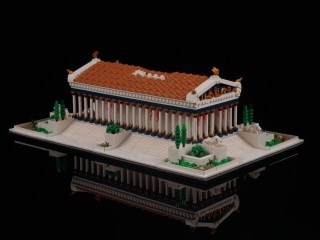
As voting for BrickLink Designer Program series eight continues, we have another article about one of the submissions, written by its designer, James, aka Brick_Belt:
A long term goal of mine has been to complete LEGO models of the Seven Wonders of the Ancient World. Between researching, designing and a little thing called life it has been a long, slow process.
The Temple of Artemis was one of my earliest models, dating back nearly a decade. Early iterations were poor, but as more pieces became available and my skill improved the model has grown into something that I believe represents the splendour of the original Wonder well.
I always try to design my models to the standards of regular sets, so designing the Temple around the constraints of the Bricklink Designer Program was a natural fit and here I have prepared it for Series 8.
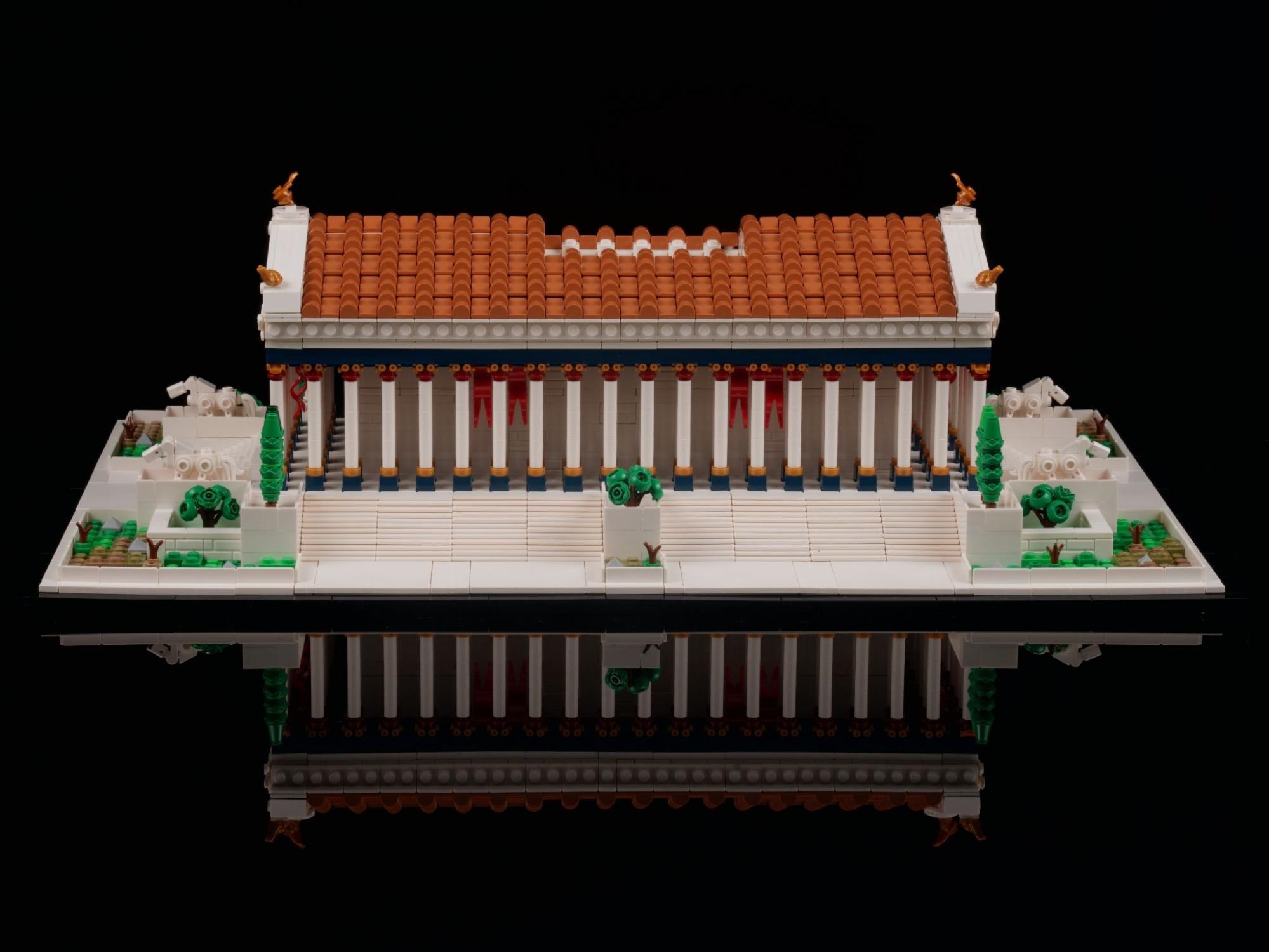
I wouldn’t claim to be an expert of history or architecture, but historical wonders have always been a point of fascination for me. The Temple of Artemis in particular was considered one of the most magnificent of the Seven Wonders, and was likely the most exquisite temple in all of Greece. I go into more detail on the history of the Wonder itself in my Bricklink description, which I would encourage anyone who is interested to read.
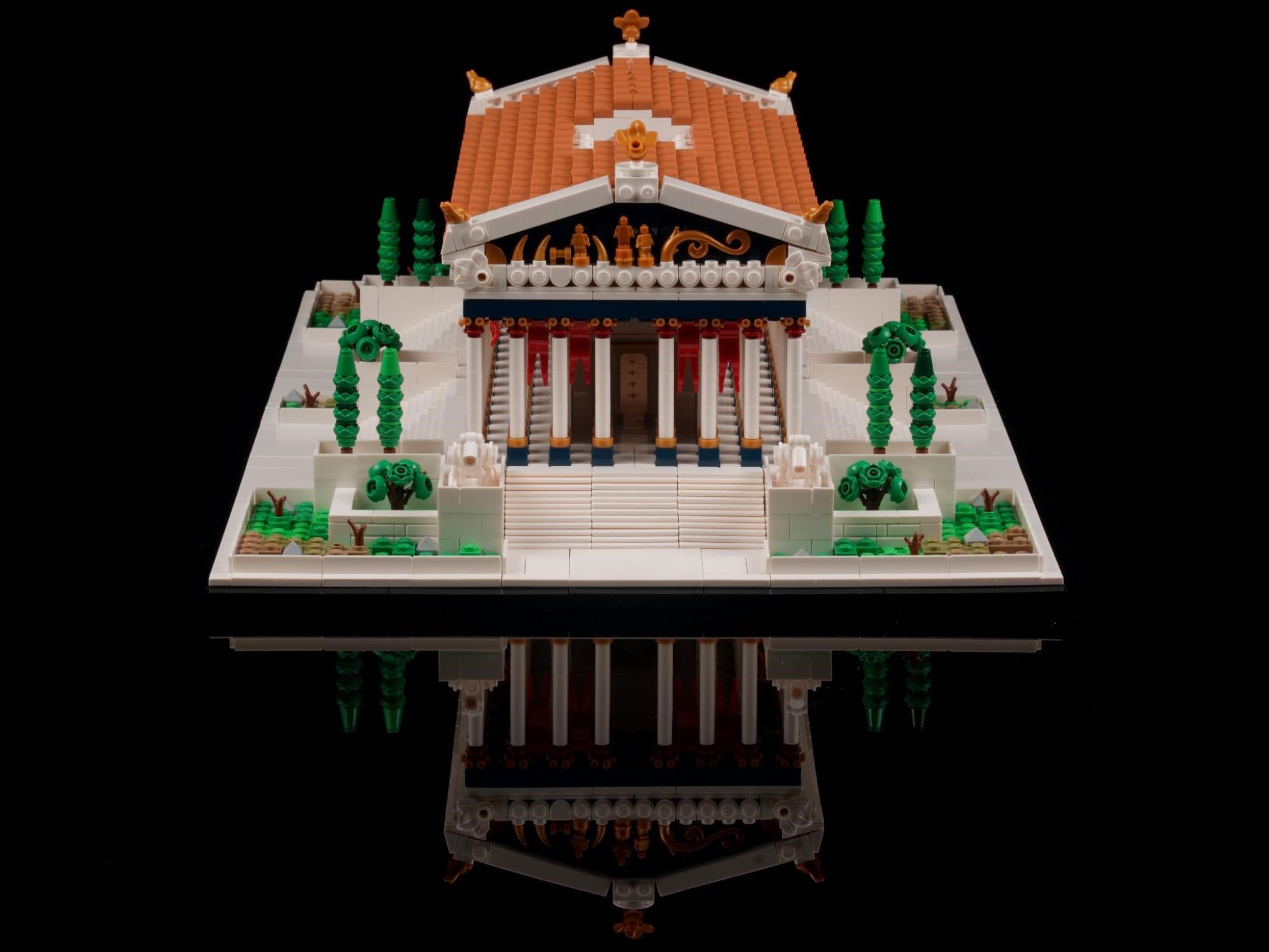
Initially, I set out to create a much longer article detailing more about the Temple and my research, but as my word count eclipsed 4,000 words I realised I needed to reign it in. I would be more than happy to answer any questions in the comments.
Any kind of feedback is appreciated, especially from those more knowledgeable about the subject than myself, as it is what has driven me to make many of the improvements seen in the model today. For this article I decided to narrow the focus to the design process and build.
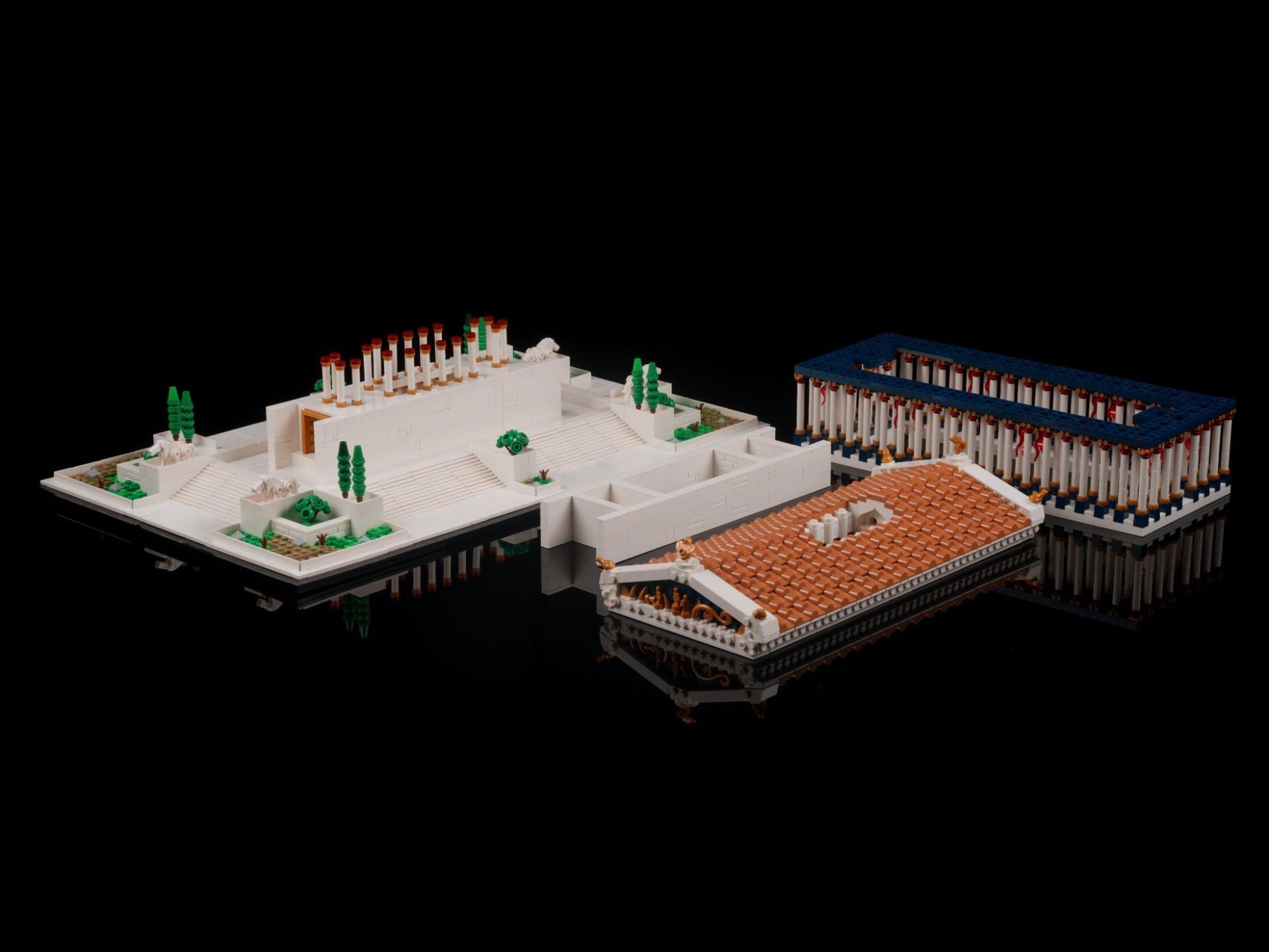
LEGO maths
To most who build a lot of LEGO this should be familiar, but I remember Brickset being one of the earliest websites I visited as a kid so for anyone who is new to LEGO or doesn’t have as much experience, here are the basics of the thickness of various LEGO pieces:
- One LEGO brick is 9.6mm tall.
- One LEGO plate is 3.2mm tall.
- Three LEGO plates make up one LEGO Brick (3 x 3.2mm = 9.6mm).
- One LEGO stud is 8mm x 8mm.
- Five LEGO plates equal 2 LEGO studs (5 x 3.2mm = 16mm).
- Various pieces, including brackets, headlight bricks, incorporate half plate thicknesses of 1.6mm. Each stud also sticks up 1.6mm (plus the height of the embossed LEGO text).
- One LEGO stud plus one half plate equal one brick (8mm + 1.6mm = 9.6mm).
- Two plates plus half a plate equal one stud (2 x 3.2mm + 1.6mm = 8mm)
Building the model
The build begins simply, using technique bricks to provide a solid core with attachment points. Each side of the temple is given a different colour. Designating the statue side of the Temple as the “North” side, North is red, South is blue, East is white and West is grey. The groundwork is laid for the building between the columns and the tilework for the interior of the Temple, the cella, is built.
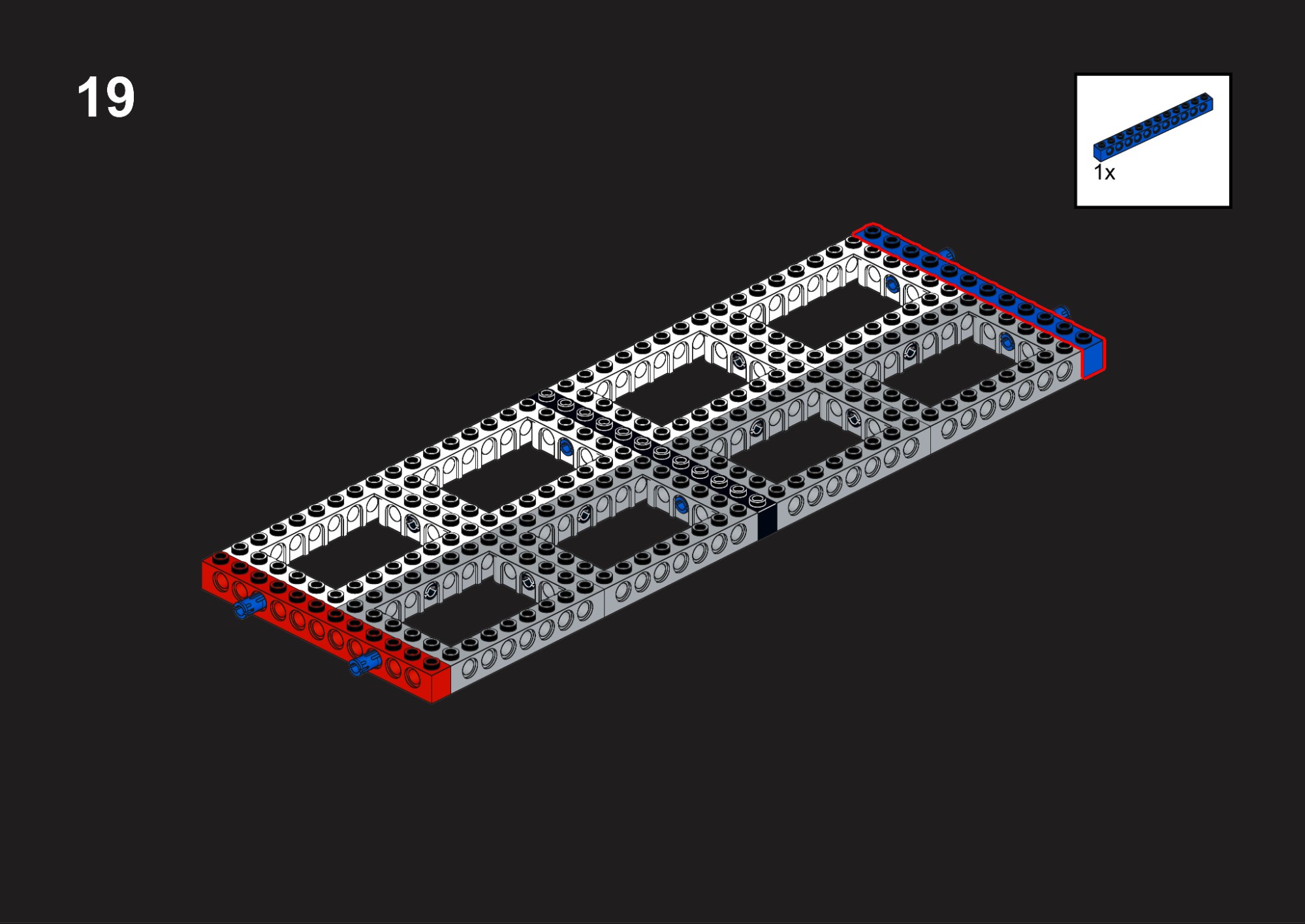
The Greeks were no strangers to exquisite tile work but the actual tile design of the Temple is unknown, so I had to come up with something on my own–not easy at such a small scale!
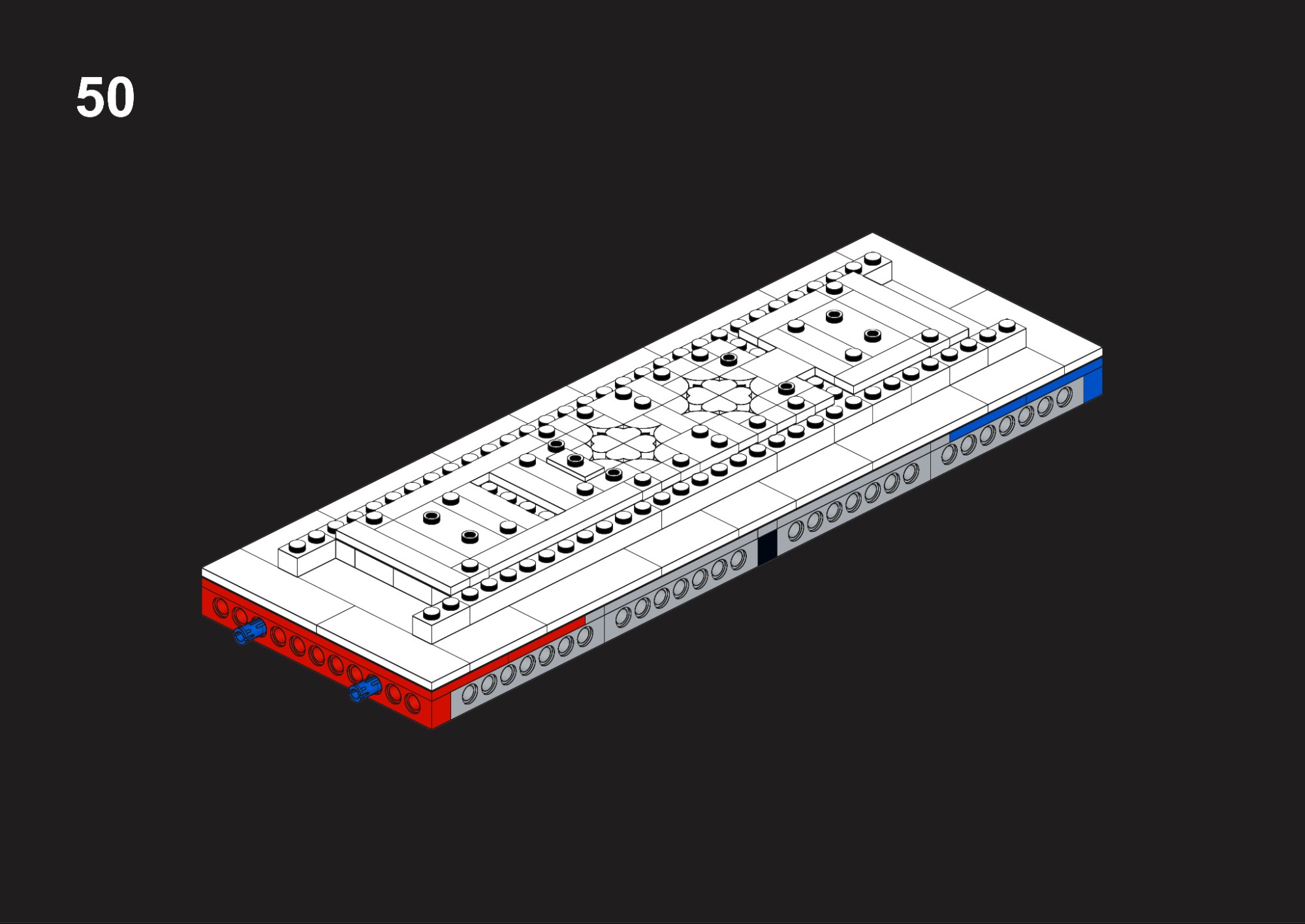
Once the core of the model is complete construction moves on to the outer steps. The third Temple of Artemis had thirteen steps leading into it. This is where our LEGO maths starts to become important. Using regular tiles with a 3.6mm thickness would have resulted in a set of steps grossly out of scale with the actual Temple. For that reason I used a technique where the 1.6mm sides of panels are stacked on top of each other to create steps that have half the thickness of a standard plate. This technique was used officially in the 2019 architecture set 21045 Trafalgar Square.
Reviewing the maths for a moment: giving the model thirteen steps would require thirteen half plate offsets. 13 x 1.6mm = 20.8mm (or 6.5 plates). This put me in a bit of an awkward spot as the entire section at the bottom of the steps would have to be offset six and a half plates from the top of the steps. With a much higher piece count and a thicker base it is possible this offset could have been achieved, but to keep things easier twelve steps are used. 12 x 1.6mm = 19.2mm (6 plates or 2 bricks). While trying to keep things accurate is important, twelve steps gives us a nice even number and allows everything to line up without making too much of a compromise.
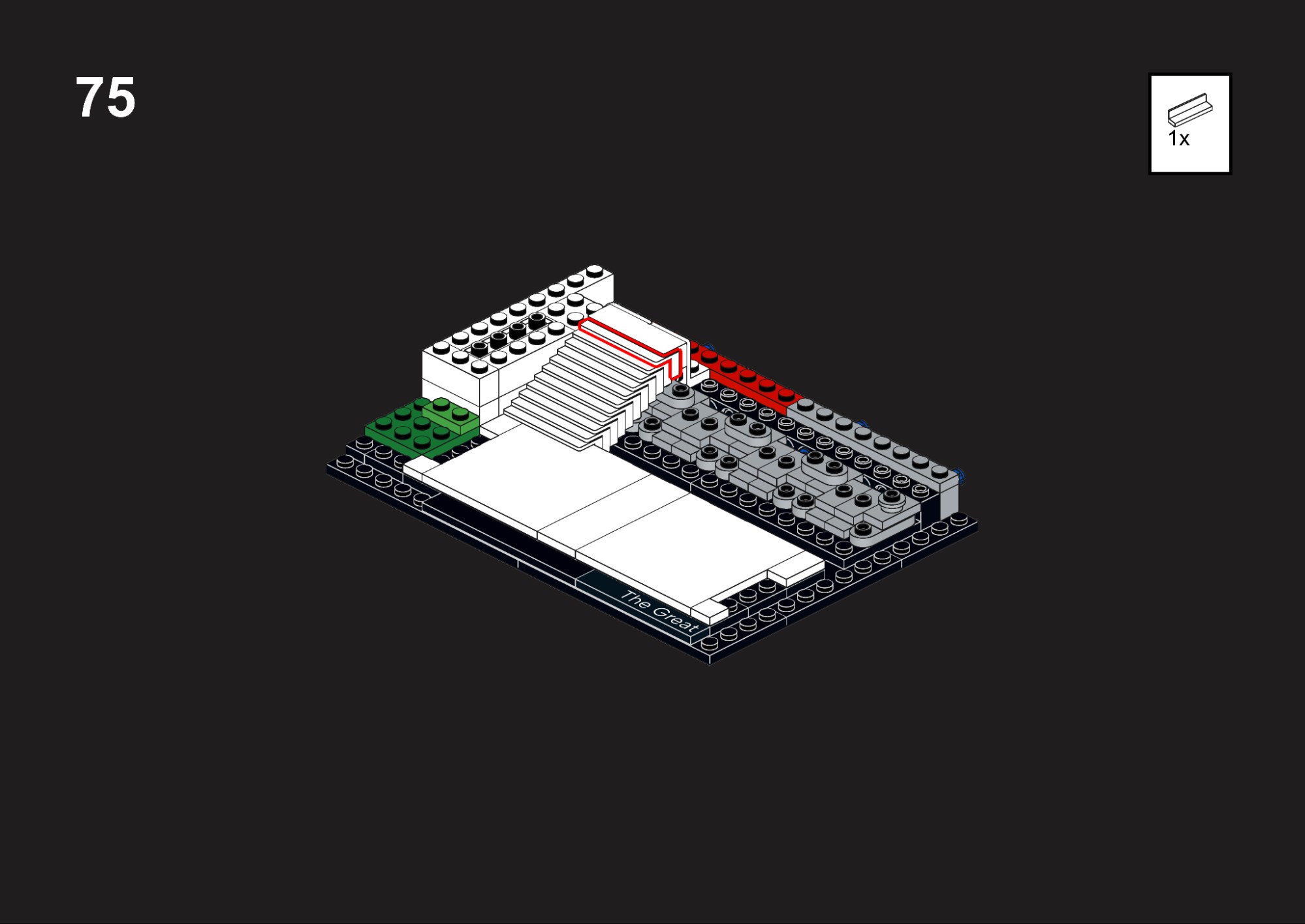
From here the steps are constructed in six different sections. Two sections on each of the long sides and one section for each short side. Construction starts with a base made of various plates. Then jumper plates are used to offset support for the panels making the steps. Open studs are used here so that the LEGO text doesn’t offset things more than the 1.6mm we are looking for. Using panels for steps makes corner steps impossible, so I have added ten raised platforms spaced throughout. While it is unknown if these were present in the actual Temple, they are fairly common in various depictions. The raised platforms also serve a functional purpose for the model as they prevent the panels from sliding out the side during building.
Once the first two sets of steps are done, the raised platform between the two sets of steps is added and then the build is repeated on the opposite side. Here is where the colour coding noted earlier becomes helpful, as it keeps the builder oriented to the rotation of the model. The steps at the North and South ends feature a large, stepped, grassy area utilising green, bright green, olive green and dark tan to closely match the landscape of the actual Temple site.
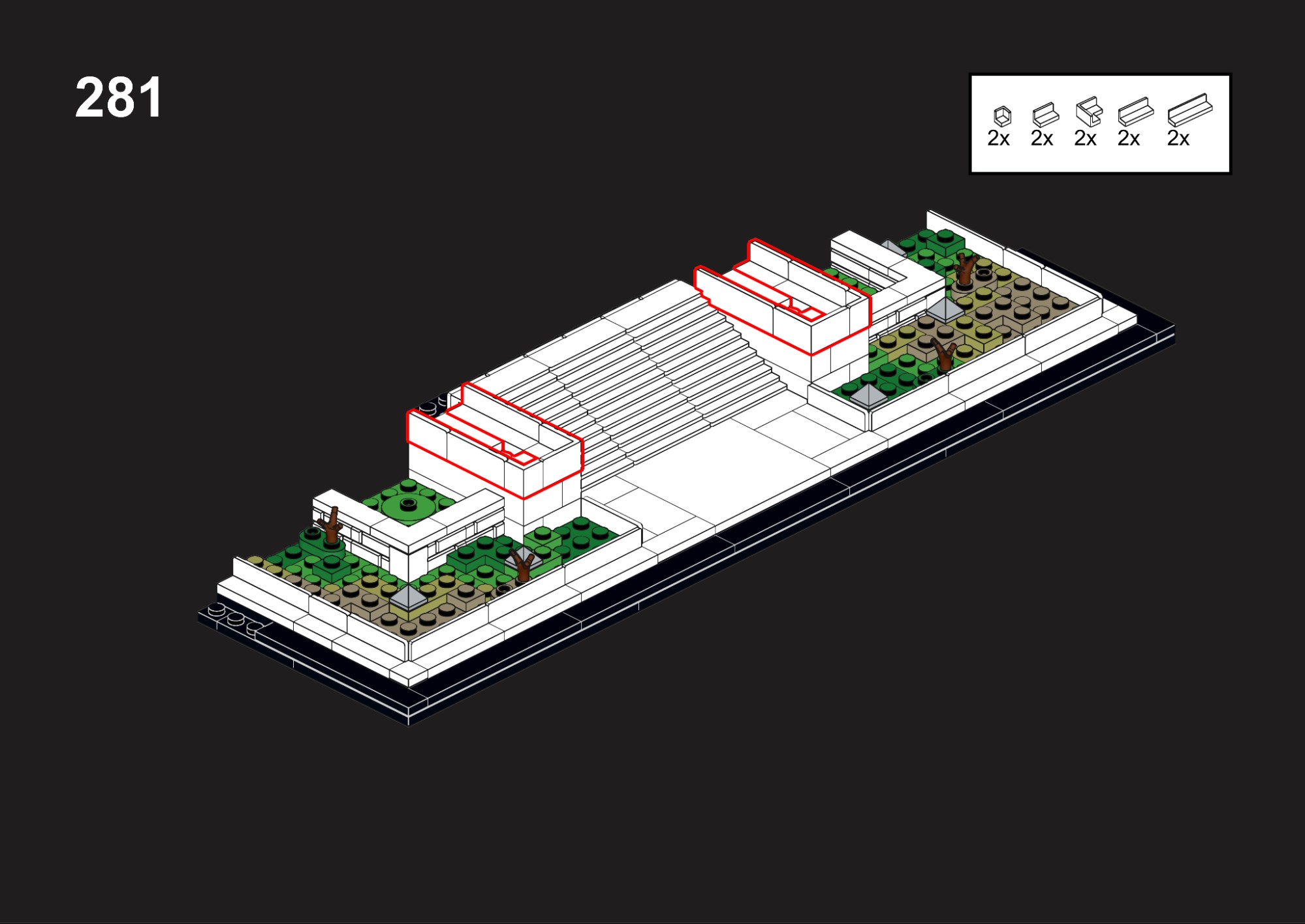
Once the steps are all in place, construction begins on the Temple’s main structure. The statue of Artemis is built using a simple three-piece combination with the end of a broom, a fur collar, and a LEGO head. From there, construction continues with forty interior columns, the lower walls, and removable second floor walls. The removable upper floor makes it much easier to access and admire the interior detail after construction is complete.
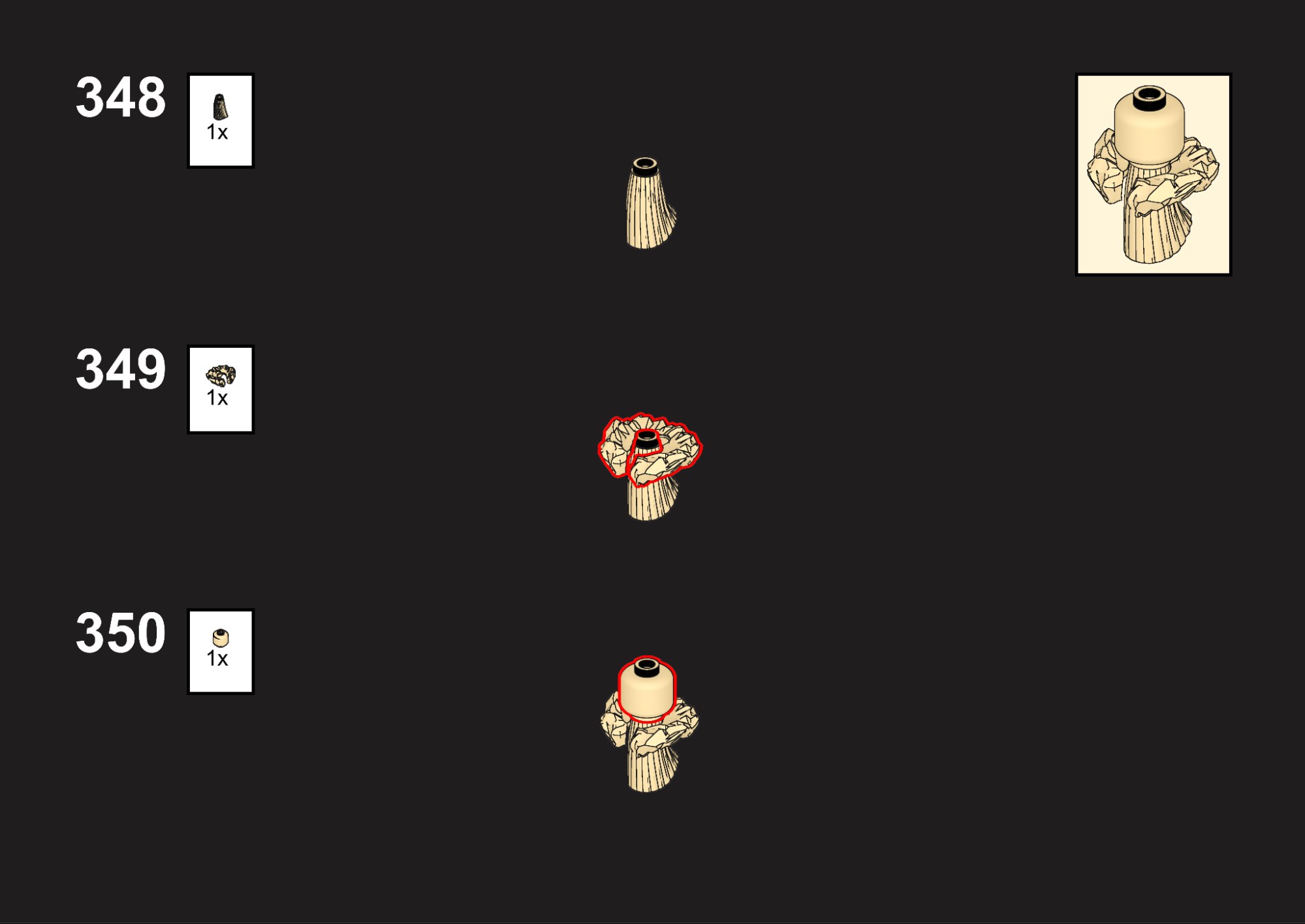
The one hundred exterior columns were one of the most magnificent elements of the Temple of Artemis. I initially used the part 43888 for each column, which helped keep the piece count down. However, it meant that each column was monochrome. To allow for more colour and accurate sizing, I switched to candlesticks–unfortunately the columns now use 600 pieces instead of 100! Thankfully, the pieces are small so the amount of plastic used has actually decreased. According to Bricklink, the new columns weigh 1.54g while the old ones weighed 2g, which should help keep the cost down despite the increased piece count.
When it comes to constructing the columns, I decided to make the entire section removable, if desired, to better view the model’s interior. Each column starts with a 1 x 1 brick that sits recessed in the base, which ensures that the bricks stay oriented in the right direction. At the top of the candlesticks, open 1 x 1 round plates are placed upside down and then adorned with a gold capital (a roller skate piece). The columns are topped with a navy-blue-painted architrave which keeps the whole structure stable. Red decorative banners hang down between the columns. To prevent the build from getting repetitive, only a few columns are placed at a time before adding that section of the architrave, which helps keep things stable and breaks up the build experience.
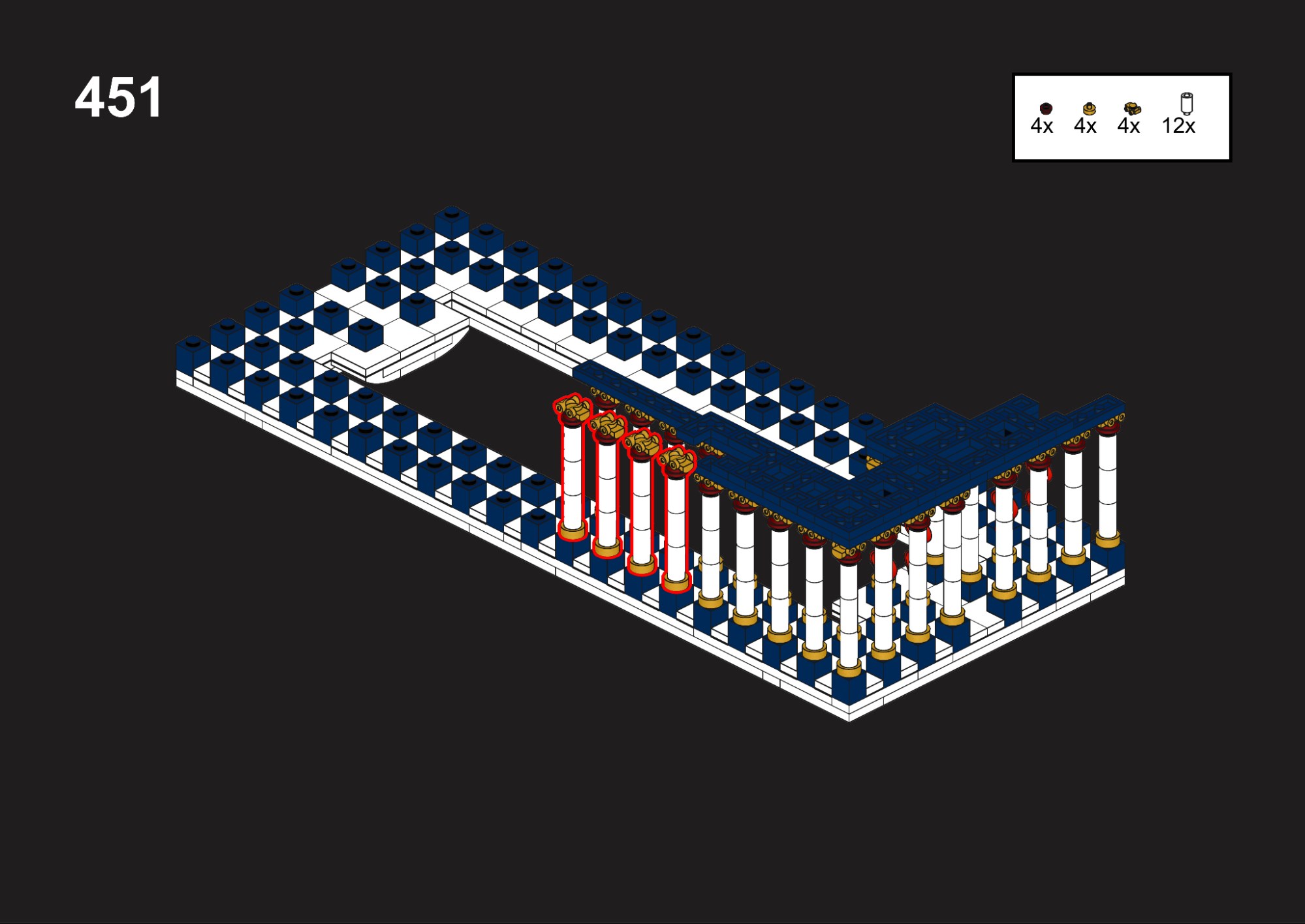
Building the removable column structure presented multiple design issues. I initially used inverted slopes on the base as I was concerned it wouldn’t slide easily into the inset area of the base. These were a pain to attach the columns to as they didn't lay flat and came apart when you tried to press a piece down into them. If you slow down my timelapse you may be able to see the struggle.
Thankfully, the flat base is sturdier and the column section still slides into the base fine. The second issue arose with the roller skates, which have a small portion that juts out on the side of the stud. This made the construction of the architrave much more difficult so I made the decision to invert the skates.
Thankfully this worked well, however it does present an issue as the stud thickness offsets the top of the columns by a half plate, 1.6mm, which will need to be accounted for when building the roof. Inverting the studs had the added benefit of creating a flat anti-stud surface for the roof to sit on unattached so can be removed–one of the most requested features from earlier iterations.
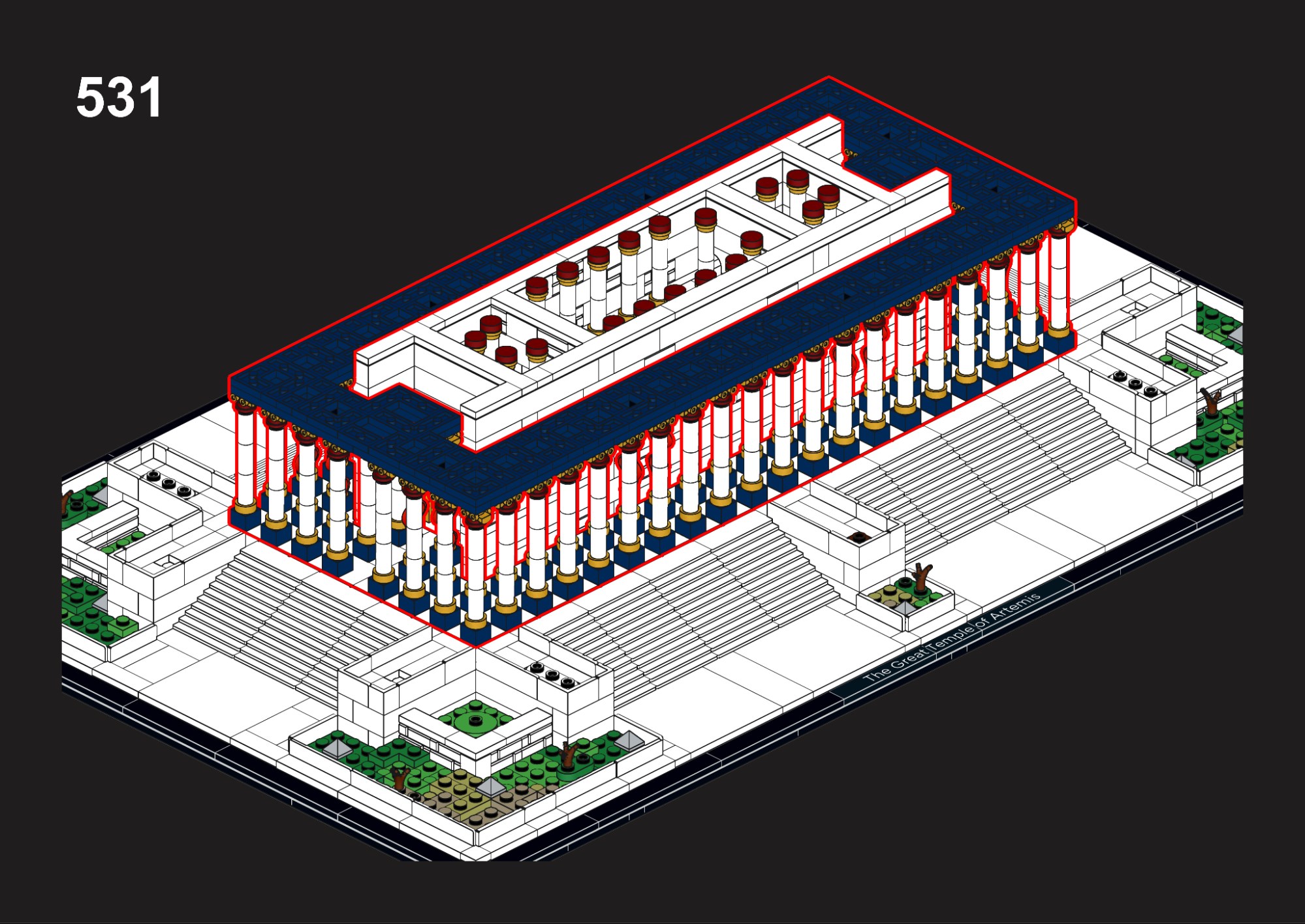
The roof starts with a straightforward core with SNOT attachments on the sides.
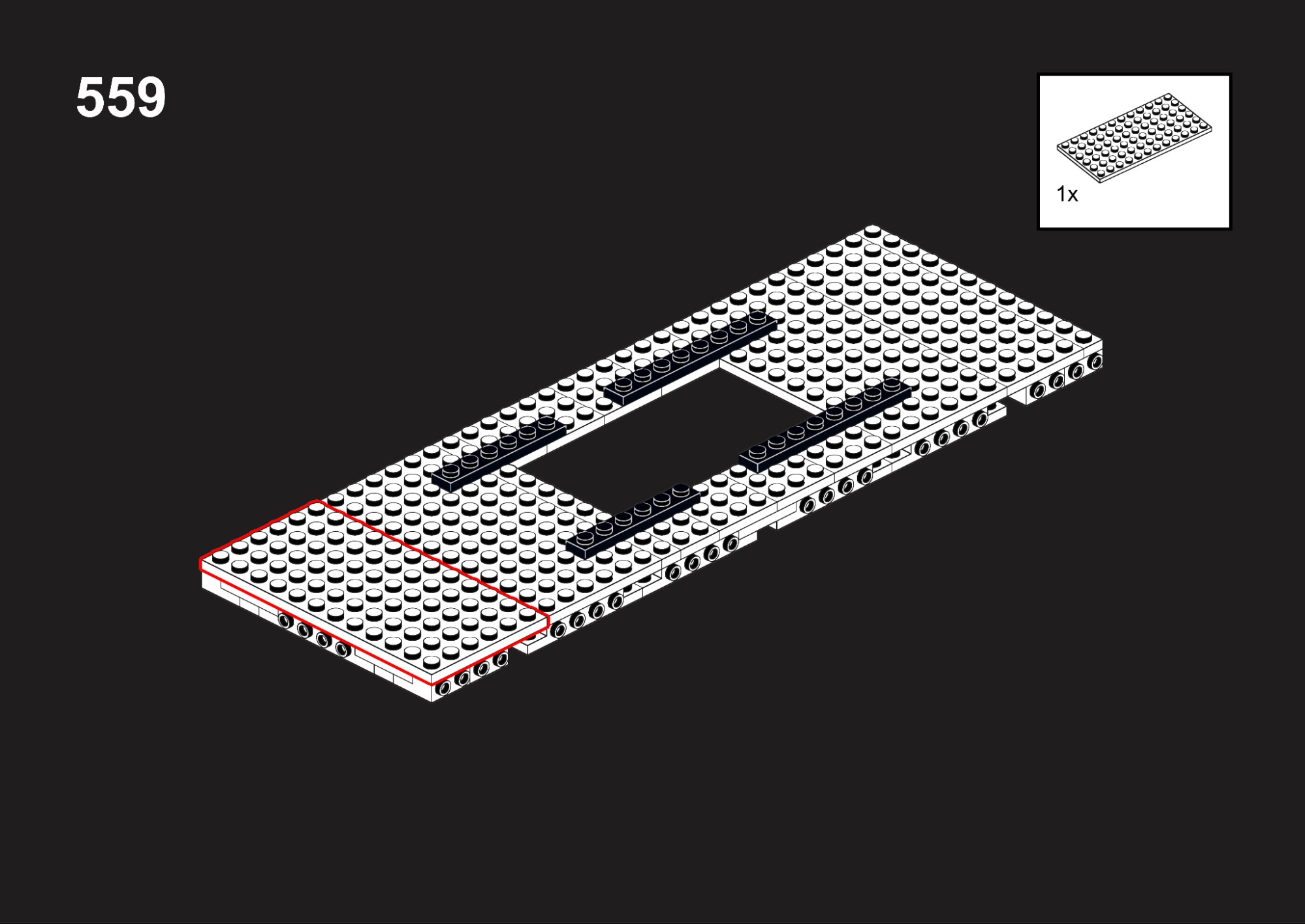
From here a series of brackets are used on the sides: First a bracket facing upwards, providing an upward set of studs that aligns with the rest of the plates.
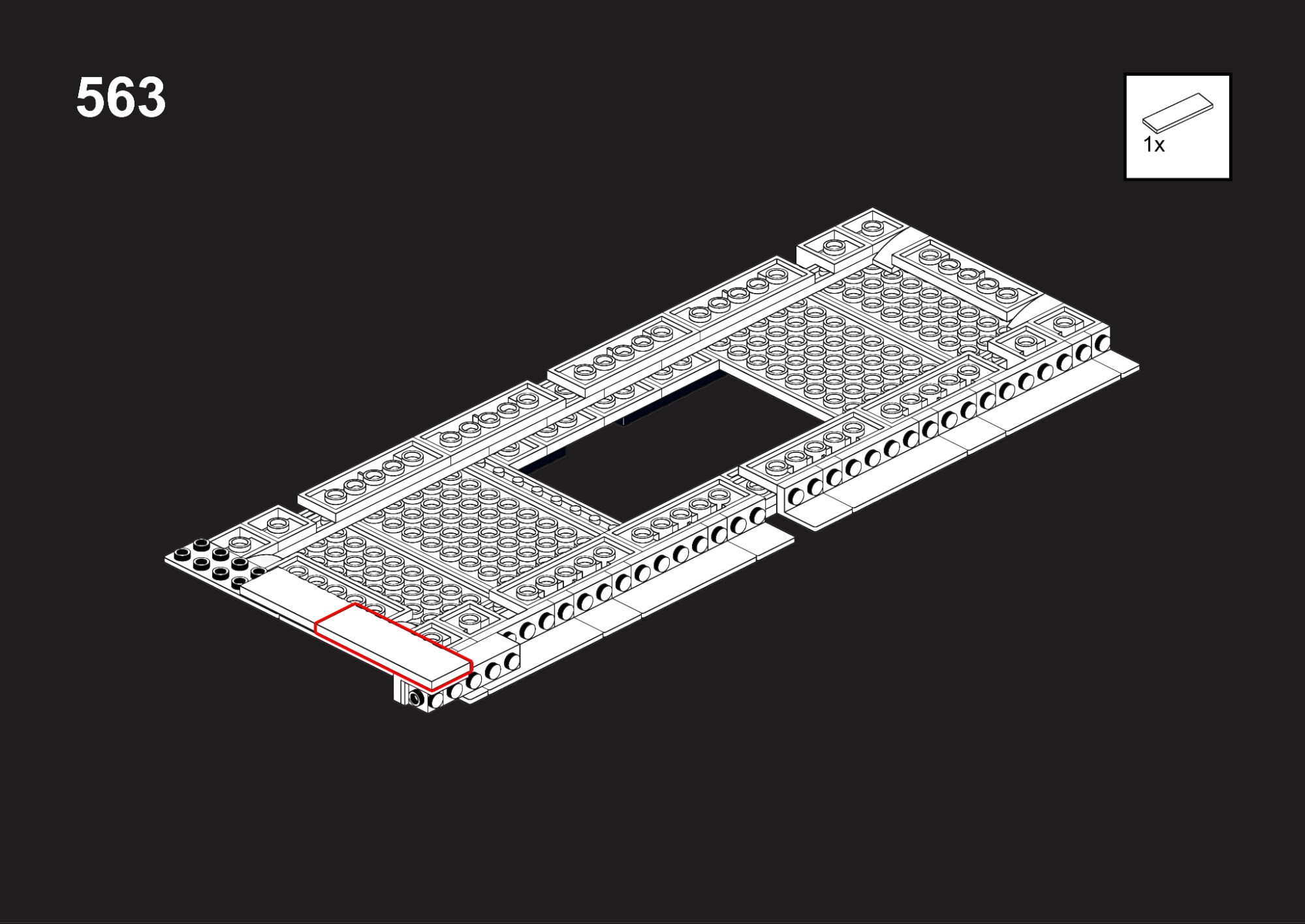
Then a brick is placed followed by a bracket facing downwards. This offsets the bottom of the roof along the outside of the sides half a plate (1.6mm) so that it aligns with the offset architrave from the columns.
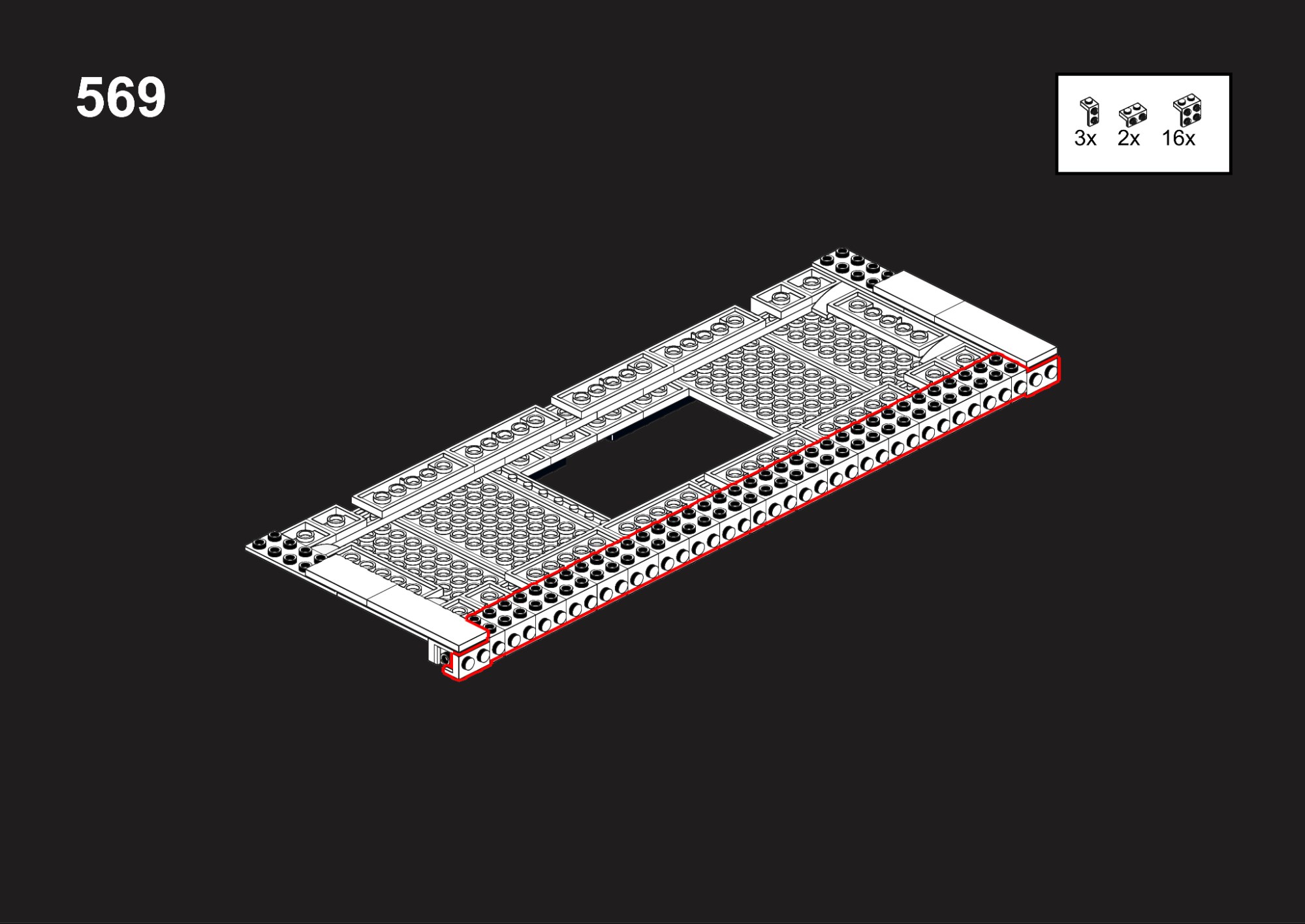
Lastly, the sides are finished with a bracket facing upwards for the roof tiles to be placed on. For the cornice, which juts out the sides, I found that a full plate thickness didn’t look right so brackets are used for a more appropriate half plate thickness. I considered using some sort of tiles for the frieze on the side but ultimately I decided the bare studs looked just as good and allowed for the cornice to have an appropriate depth.
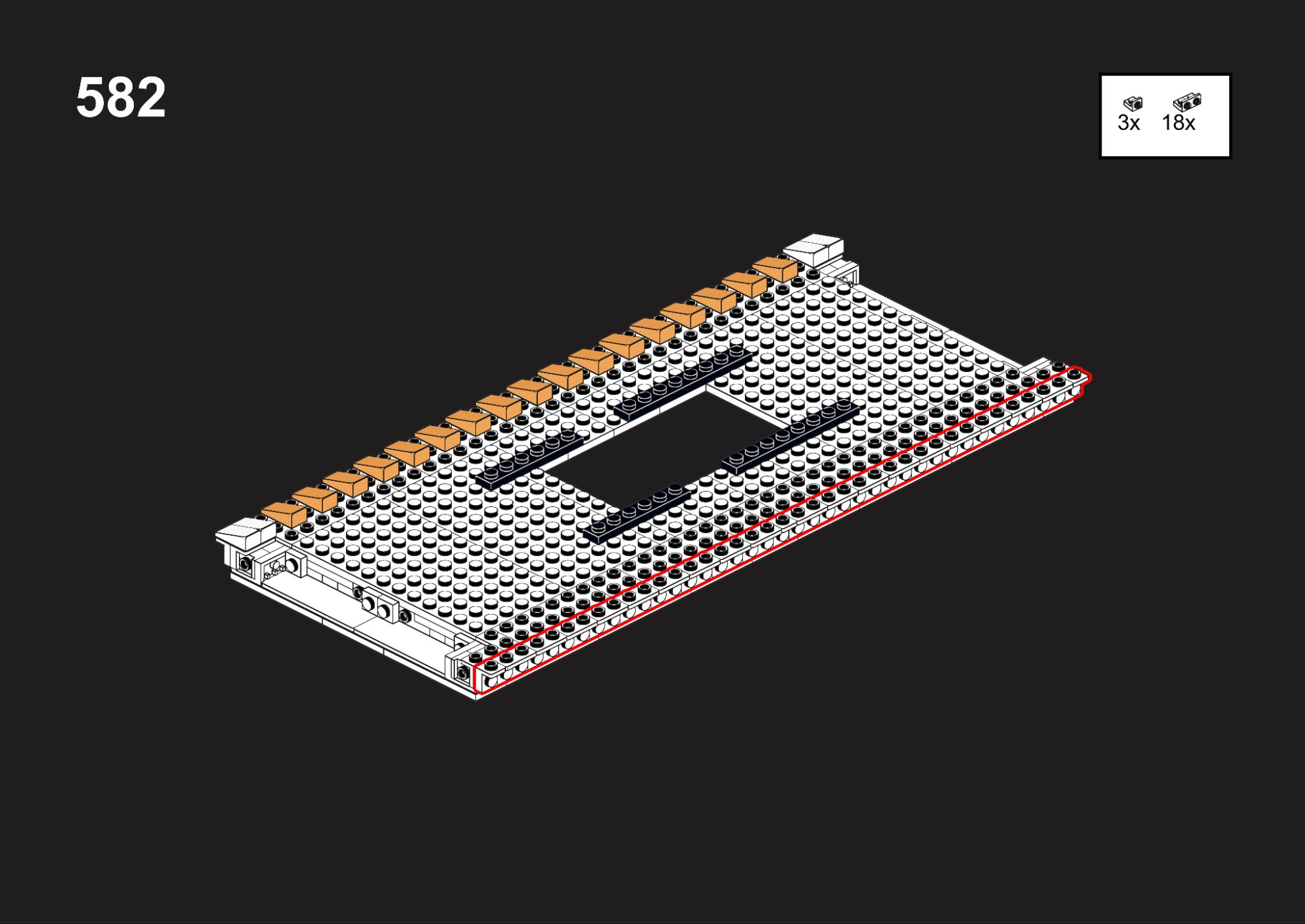
The tilework on the roof has been a defining feature of the model for a while and got a nice upgrade with this iteration thanks to the introduction of the 1 x 2 x ? slope. This also helped reduce the piece count and make the roof less tedious. To avoid making the builder place all the tiles on at once, the tiles are placed bit by bit as the whole roof is built.
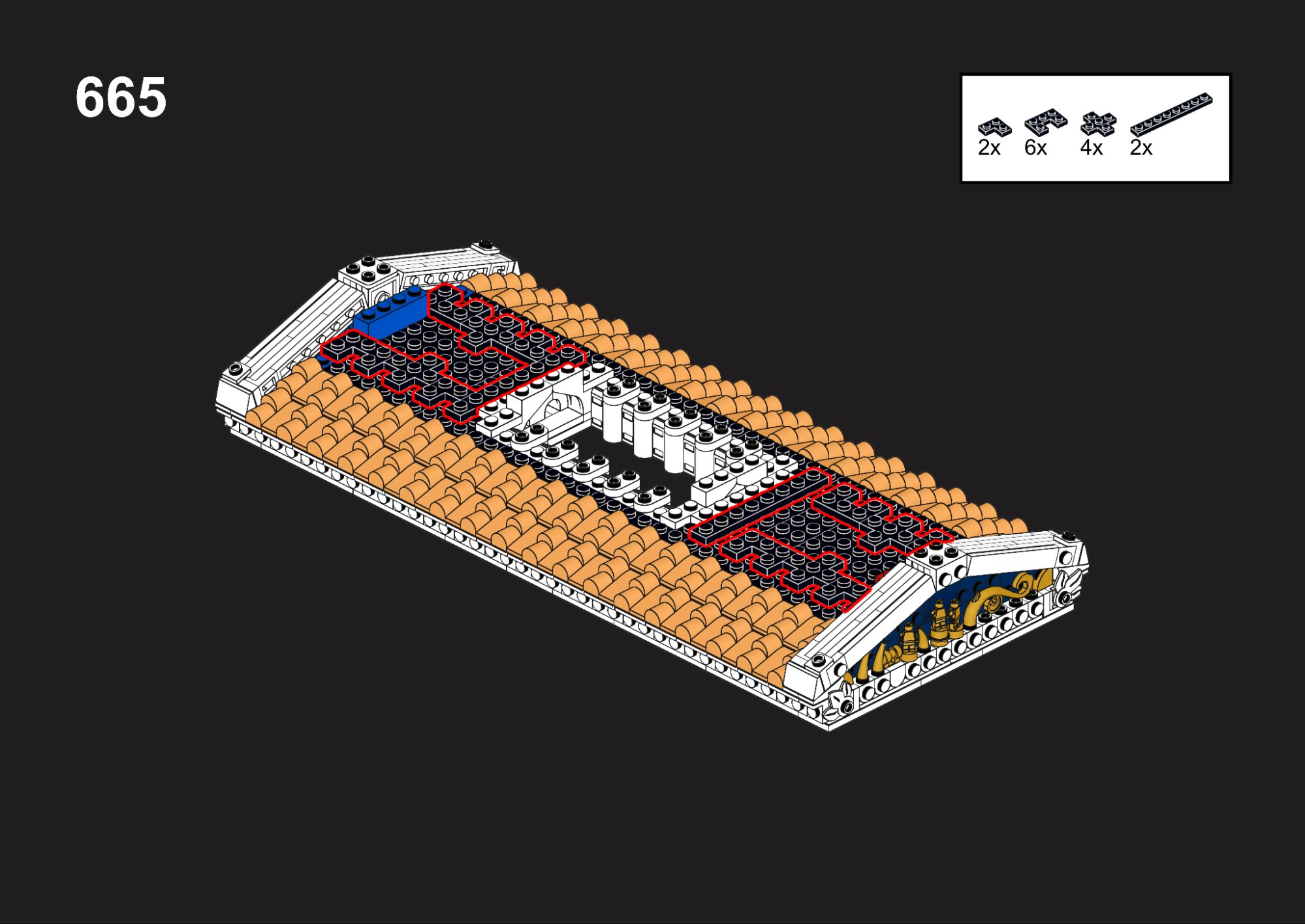
Each end of the roof has a triangular sculpted section called the pediment. The general construction of the pediment has remained the same now for a number of years, but naturally there have been some minor changes. SNOT bricks are used along with wedge plates to give the triangular shape. Wedge plates with the right angle that go to a full point do not exist, so the wedge plates are lined up with 1 x 2 x ? slopes at the end to make a perfectly continuous line. Hinge plates are used to provide the angled top which sits on top of the wedge plates. The relatively new 1 x 1 x ? SNOT bricks allow for statuettes and other sculpted details to be added.
For the finishing touches horse statues, which were found during excavation work, are placed at each end. Cypress trees, which are associated with Artemis, and mulberry trees, which line the road to the modern-day site, are added all over the model. These final touches give a splash of colour and add some organic details.
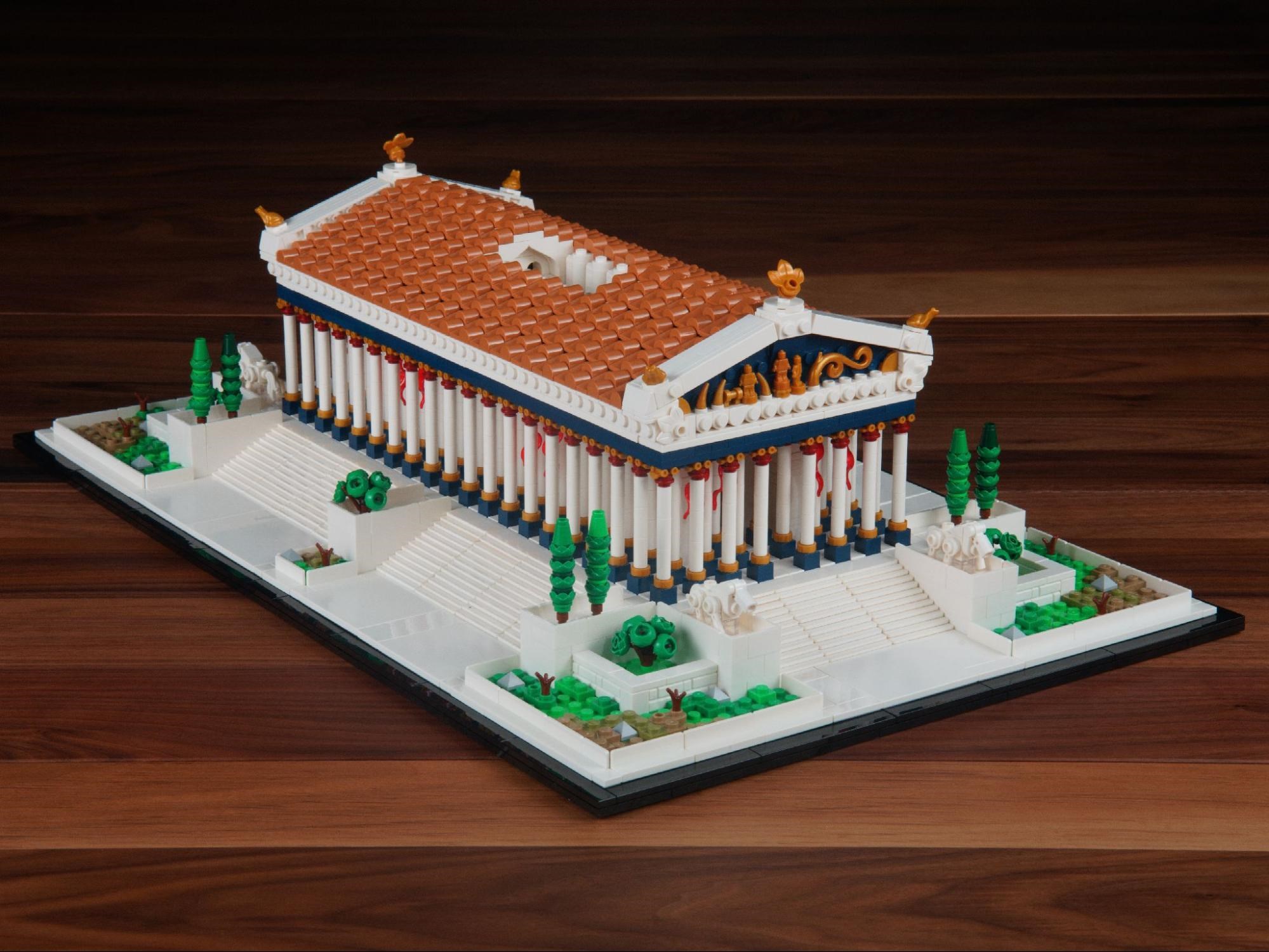
What's next
Naturally while the Temple of Artemis is “complete”, homemade models are always a constant work in progress. I already have a few changes in mind to improve accuracy and make the model more visually appealing. Nevertheless, even without the changes, I hope you enjoy it and I hope it’s something you’d love to have on display.
Currently, the Temple sits on my shelves between the Taj Mahal and the Great Pyramid of Giza, where it feels right at home. I hope one day to have a shelf lined with all Seven Wonders of the Ancient World (plus some extras). If you’d like to see the same please consider voting on it over at the Bricklink page!
64 likes
20 comments on this article
Man I have been hoping for an ancient Greek temple set for years. Multiple Ideas projects have been rejected, I hope this goes through via Bricklink at least. It looks great.
Beautiful and visually striking model. Thanks for sharing some interesting techniques.
Nice, but nope. Absolutely, no interest.
If it was minifig scale, yes. This, no.
Lego has displayed me out. I need fun with minifigs.
@StyleCounselor said:
"Nice, but nope. Absolutely, no interest.
If it was minifig scale, yes. This, no.
Lego has displayed me out. I need fun with minifigs."
Minifigure scale would be amazing, but at least for the Temple of Artemis it would be bigger than Rivendell! Quick napkin math says roughly 40" x 20" just for the Temple and surrounding steps, and the columns would need to be 16 studs tall. Maybe one day we can at least get a facade, or half of a smaller Temple.
Adding a few Minifigures just to include is something I've really wanted to do but BDP is pretty limited in its parts selection so since I was building around that I left them out for this time.
Thanks Huw for the opportunity to share more about my model! Brickset has been one of my favorite websites for as long as I have been using the internet and the staff have always been so kind!
@Brick_Belt said:
"Thanks Huw for the opportunity to share more about my model! Brickset has been one of my favorite websites for as long as I have been using the internet and the staff have always been so kind! "
You are welcome. I look forward to featuring your model of the Hanging Gardens of Babylon next time :-)
@StyleCounselor said:
"Nice, but nope. Absolutely, no interest.
If it was minifig scale, yes. This, no.
Lego has displayed me out. I need fun with minifigs."
It would be impossible to do this legendary temple justice in any realistic scale to a minifig and keep it under 4,000 parts. Of course, they could do smaller temples that are in minifig scale, but it's clear the designer wasn't going for just any temple, but one of the most grand buildings on the ancient world. I'm sure there are plenty of backers for buildings in this scale, and it does look beautiful. But like you, I also only buy minifig-scale sets, because minifigs make everything more fun.
Wow the patience to do this in Studio, so much detail and upside down at times! Thank you for sharing your submission and posting this article as some interesting architectural building techniques, I really like the stairs on step 75, and roller skates for the Ionic column tops.
@Brick_Belt said:
" @StyleCounselor said:
"Nice, but nope. Absolutely, no interest.
If it was minifig scale, yes. This, no.
Lego has displayed me out. I need fun with minifigs."
Minifigure scale would be amazing, but at least for the Temple of Artemis it would be bigger than Rivendell! Quick napkin math says roughly 40" x 20" just for the Temple and surrounding steps, and the columns would need to be 16 studs tall. Maybe one day we can at least get a facade, or half of a smaller Temple.
Adding a few Minifigures just to include is something I've really wanted to do but BDP is pretty limited in its parts selection so since I was building around that I left them out for this time. "
@ToysFromTheAttic
I understand. I hope my flippancy wasn't too off-putting. I do like your design.
I just have way too much, and like I said, Lego has provided sooooooo many display items to me that my tolerance for any more is extremely, extremely limited. The only way I can justify (there really isn't any) further purchases is their adherence to a previous theme or playability with minifigs.
That said, a sacrifice of some scale and realism would be worth it to get a cool, Greek-style temple in minifig scale. That type of set could potentially be added to many, many existing AFOL layouts. I would buy it.
@ambr said:
"Wow the patience to do this in Studio, so much detail and upside down at times! Thank you for sharing your submission and posting this article as some interesting architectural building techniques, I really like the stairs on step 75, and roller skates for the Ionic column tops."
The stairs are a copy of the technique used in Trafalgar Square which was mentioned in the Brickset review of the set six years ago ...
https://brickset.com/article/43714/review-21045-trafalgar-square
@StyleCounselor said:
" @Brick_Belt said:
" @StyleCounselor said:
"Nice, but nope. Absolutely, no interest.
If it was minifig scale, yes. This, no.
Lego has displayed me out. I need fun with minifigs."
Minifigure scale would be amazing, but at least for the Temple of Artemis it would be bigger than Rivendell! Quick napkin math says roughly 40" x 20" just for the Temple and surrounding steps, and the columns would need to be 16 studs tall. Maybe one day we can at least get a facade, or half of a smaller Temple.
Adding a few Minifigures just to include is something I've really wanted to do but BDP is pretty limited in its parts selection so since I was building around that I left them out for this time. "
@ToysFromTheAttic
I understand. I hope my flippancy wasn't too off-putting. I do like your design.
I just have way too much, and like I said, Lego has provided sooooooo many display items to me that my tolerance for any more is extremely, extremely limited. The only way I can justify (there really isn't any) further purchases is their adherence to a previous theme or playability with minifigs.
That said, a sacrifice of some scale and realism would be worth it to get a cool, Greek-style temple in minifig scale. That type of set could potentially be added to many, many existing AFOL layouts. I would buy it."
I wonder if maybe a half temple could work? Would probably have to be based on one that has a single row of columns like the Parthenon. If someone purchased two they could then put them together for a full temple. Between those two concessions it would still be a large and expensive set but I would think it could still be kept in a reasonable range.
That one is an interesting one as we aren't even sure they actually existed!
Oh my, this is completely beautiful! The way it is built is outstanding, great care has been put into this design!
Looks great! Awesome write-up, Its very fun to see the stories and techniques behind these BDP submissions. Good luck!
Mighty impressed.
The end result looks great and the insight into the design process is fascinating.
Thank you so much for sharing.
I wish I had such skills, as I absolutely love ancient architecture and have been a fan of the seven wonders of the world ever since I got a book about them as a kid.
@Brick_Belt said:
" @StyleCounselor said:
" @Brick_Belt said:
" @StyleCounselor said:
"Nice, but nope. Absolutely, no interest.
If it was minifig scale, yes. This, no.
Lego has displayed me out. I need fun with minifigs."
Minifigure scale would be amazing, but at least for the Temple of Artemis it would be bigger than Rivendell! Quick napkin math says roughly 40" x 20" just for the Temple and surrounding steps, and the columns would need to be 16 studs tall. Maybe one day we can at least get a facade, or half of a smaller Temple.
Adding a few Minifigures just to include is something I've really wanted to do but BDP is pretty limited in its parts selection so since I was building around that I left them out for this time. "
@ToysFromTheAttic
I understand. I hope my flippancy wasn't too off-putting. I do like your design.
I just have way too much, and like I said, Lego has provided sooooooo many display items to me that my tolerance for any more is extremely, extremely limited. The only way I can justify (there really isn't any) further purchases is their adherence to a previous theme or playability with minifigs.
That said, a sacrifice of some scale and realism would be worth it to get a cool, Greek-style temple in minifig scale. That type of set could potentially be added to many, many existing AFOL layouts. I would buy it."
I wonder if maybe a half temple could work? Would probably have to be based on one that has a single row of columns like the Parthenon. If someone purchased two they could then put them together for a full temple. Between those two concessions it would still be a large and expensive set but I would think it could still be kept in a reasonable range. "
As long as it still looks impressive from all sides. We AFOLs love buildings that work with our minifigs AND look great on display with our other stuff (modulars, towns, ships, etc.).
@Brick_Belt said:
"Thanks Huw for the opportunity to share more about my model! Brickset has been one of my favorite websites for as long as I have been using the internet and the staff have always been so kind! "
This was supposed to be in response to Huw about the Hanging Gardens. Makes much more sense with that in mind . . .
@StyleCounselor said:
" @Brick_Belt said:
" @StyleCounselor said:
" @Brick_Belt said:
" @StyleCounselor said:
"Nice, but nope. Absolutely, no interest.
If it was minifig scale, yes. This, no.
Lego has displayed me out. I need fun with minifigs."
Minifigure scale would be amazing, but at least for the Temple of Artemis it would be bigger than Rivendell! Quick napkin math says roughly 40" x 20" just for the Temple and surrounding steps, and the columns would need to be 16 studs tall. Maybe one day we can at least get a facade, or half of a smaller Temple.
Adding a few Minifigures just to include is something I've really wanted to do but BDP is pretty limited in its parts selection so since I was building around that I left them out for this time. "
@ToysFromTheAttic
I understand. I hope my flippancy wasn't too off-putting. I do like your design.
I just have way too much, and like I said, Lego has provided sooooooo many display items to me that my tolerance for any more is extremely, extremely limited. The only way I can justify (there really isn't any) further purchases is their adherence to a previous theme or playability with minifigs.
That said, a sacrifice of some scale and realism would be worth it to get a cool, Greek-style temple in minifig scale. That type of set could potentially be added to many, many existing AFOL layouts. I would buy it."
I wonder if maybe a half temple could work? Would probably have to be based on one that has a single row of columns like the Parthenon. If someone purchased two they could then put them together for a full temple. Between those two concessions it would still be a large and expensive set but I would think it could still be kept in a reasonable range. "
As long as it still looks impressive from all sides. We AFOLs love buildings that work with our minifigs AND look great on display with our other stuff (modulars, towns, ships, etc.)."
As an AFOL you could make anything work, obviously, but I don't think Bricklink is aimed specifically at AFOLs. But perhaps LEGO will sell you half a temple someday. They did that with the Great Pyramid of Giza, and that seemed to work. But that one wasn't minifig scale either. As far as non-licensed sets go, there's definitely a maximum number of pieces you're going to get out of a set, so that really limits the numbers of historical buildings LEGO can accurately produce at minifig scale. I'm also sure they're not too concerned about AFOLFs in that regard. You know where to get your bricks, after all.
As an archaeologist with a specialization in Antiquity, this should be right up my alley. I'm hoping to one day make LEGO models of some of the buildings that came back to light during our excavation campaigns in Turkey.
That said, I'd support this project but I would probably not buy it myself. I get most joy from the building process and from interacting with my sets. This looks quite repetitive, which is also the main reason why I didn't buy the Colosseum.
For me personally I would be very interested in a minifig scale facade of this temple (perhaps like the Treasury in Petra). At the right scale minifigs would be absolutely dwarfed by the steps and columns, without running into too high a piece count. This set could then come to life with some unique minifigs (priest(esse)s, soldiers, worshippers, some sacrificial animals, a funerary procession and pyre,... Ok, maybe this is turning a bit too macabre for an official set). I like that you included some surrounding scenery. That could stay included as well.
@Elcascador said:
"As an archaeologist with a specialization in Antiquity, this should be right up my alley. I'm hoping to one day make LEGO models of some of the buildings that came back to light during our excavation campaigns in Turkey.
That said, I'd support this project but I would probably not buy it myself. I get most joy from the building process and from interacting with my sets. This looks quite repetitive, which is also the main reason why I didn't buy the Colosseum.
For me personally I would be very interested in a minifig scale facade of this temple (perhaps like the Treasury in Petra). At the right scale minifigs would be absolutely dwarfed by the steps and columns, without running into too high a piece count. This set could then come to life with some unique minifigs (priest(esse)s, soldiers, worshippers, some sacrificial animals, a funerary procession and pyre,... Ok, maybe this is turning a bit too macabre for an official set). I like that you included some surrounding scenery. That could stay included as well."
Yeah repetiveness an issue with a lot of the architecture models. I managed to break up a lot of the build so thankfully it is a lot better than the Colosseum, but there's still repetive elements.
I pre-built the columns, which took about ten minutes, but here is a timelapse of the entire build minus that: https://youtu.be/h2xd6y0AHII?feature=shared